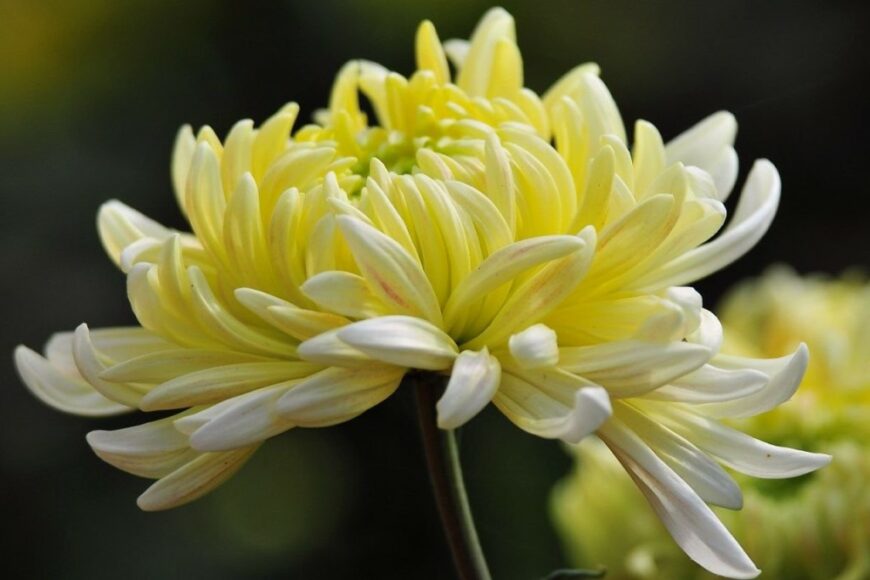
 Name: Chrysanthemum, sometimes called mum or chrysanth
Name: Chrysanthemum, sometimes called mum or chrysanth  Family: Asteraceae
Family: Asteraceae Origins: Chrysanthemums are native to East Asia and northeastern Europe. Most species originate from East Asia and the center of diversity is in China.
Origins: Chrysanthemums are native to East Asia and northeastern Europe. Most species originate from East Asia and the center of diversity is in China. Humidity: Chrysanthemums prefer moderate to high humidity.
Humidity: Chrysanthemums prefer moderate to high humidity. Location: Chrysanthemums grow best in full sun to partial shade.
Location: Chrysanthemums grow best in full sun to partial shade. Soil: Chrysanthemums prefer well-drained, fertile soil with a pH of 6.0 to 6.5.
Soil: Chrysanthemums prefer well-drained, fertile soil with a pH of 6.0 to 6.5. Pests and diseases: Chrysanthemums are susceptible to aphids, spider mites, and powdery mildew.
Pests and diseases: Chrysanthemums are susceptible to aphids, spider mites, and powdery mildew. Care: Chrysanthemums need to be watered regularly and fertilized every two weeks. They should be deadheaded to encourage reblooming.
Care: Chrysanthemums need to be watered regularly and fertilized every two weeks. They should be deadheaded to encourage reblooming. Height of growth: Chrysanthemums can grow up to 4 feet tall.
Height of growth: Chrysanthemums can grow up to 4 feet tall. Planting in the soil: Chrysanthemums can be planted in the spring or fall. They should be planted 12 to 18 inches apart.
Planting in the soil: Chrysanthemums can be planted in the spring or fall. They should be planted 12 to 18 inches apart. Blooming: Chrysanthemums bloom in late summer and fall.
Blooming: Chrysanthemums bloom in late summer and fall.With their vibrant blooms and diverse forms, chrysanthemums, also known as mums, have captivated gardeners and flower enthusiasts for centuries. These versatile flowers, native to East Asia and northeastern Europe, have been cultivated in gardens and prized for their beauty and symbolism for over 2,000 years.
Content:
Diversity in Blooms and Forms
Chrysanthemums offer an astonishing range of flower shapes and sizes, from small daisy-like blooms to large, intricate pompons and feathery spiders. Their colors span the spectrum, from pure white to fiery red, sunny yellow, and deep purple. This diversity has led to the classification of chrysanthemums into over 20,000 varieties, each with its unique charm.
Symbolism and Significance
In many cultures, chrysanthemums hold deep symbolic meaning. In China, they represent long life and prosperity, while in Japan, they are associated with longevity and happiness. Chrysanthemums are also often used in funeral arrangements, symbolizing remembrance and respect.
Adaptability and Hardiness
Chrysanthemums are remarkably adaptable plants, thriving in temperate regions around the world. They can tolerate a range of climates, from cool mountain regions to warm coastal areas. Some varieties even bloom in the winter, adding a splash of color to the otherwise dormant landscape.
Care and Cultivation
Chrysanthemums are relatively easy to grow, making them a popular choice for home gardeners. They prefer well-drained soil and full sun to partial shade. Regular watering and occasional fertilization will keep them healthy and blooming profusely.
Uses in Landscaping and Design
Chrysanthemums are versatile additions to any landscape or garden design. They can be planted in flower beds, borders, and containers, adding bursts of color and texture. Their long blooming season extends the enjoyment of autumn gardens.
Chrysanthemums: A Timeless Treasure
Chrysanthemums, with their rich history, diverse beauty, and adaptability, continue to be cherished by gardeners and flower lovers worldwide. Their versatility and symbolism make them a timeless treasure, adding vibrancy and elegance to gardens and homes across the globe.
Frequently Asked Questions (FAQs)
Q1: Can Chrysanthemums survive winter?
A1: Yes, many Chrysanthemum varieties are hardy perennials, surviving winters in well-drained soil. Mulching around the base provides additional protection.
Q2: How do I combat common pests?
A2: Keep an eye out for aphids and spider mites. Natural predators like ladybugs can assist in pest control. Insecticidal soap is effective for larger infestations.
Q3: Can Chrysanthemums be grown from seeds?
A3: While possible, growing from cuttings is more common and ensures that the new plants retain the characteristics of the parent plant.

